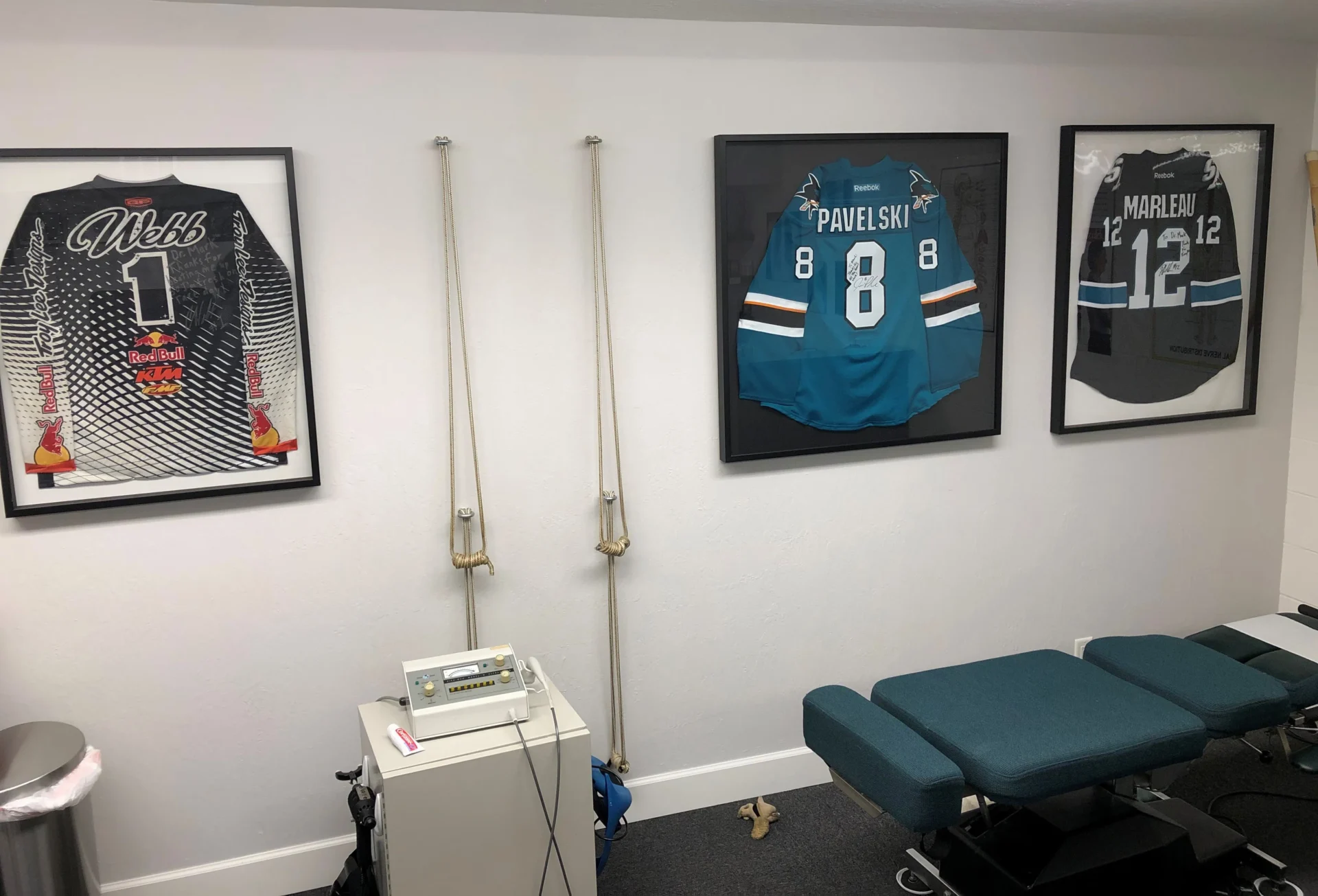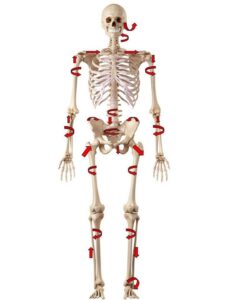Chiropractic: Introduction by Dr. Mark
Chiropractors are musculo-skeletal doctors, www.amerchiro.org. We have made a science out of approaching health care through the structural system of the body. We look at how your head sits on your body, whether or not your shoulders are level, your torso is rotated and even look at how evenly your shoes wear out. These are small indicators of how your body is functioning and how it is wearing out. We are best known for treating low back pain and neck pain, but this office specializes in treating tendonitis, headaches, TMJ issues, extremity issues, strains, sprains, post surgery recovery and a variety of injuries and ailments.
In My career I have concluded that the most important thing to manage in wellness, injury management and post-surgical injury management is the torque that manifests into the axis of the body. I call it axial torque and it is the reason I approach everything from a rehab angle.

Axial Torque is the name I have put onto this condition that I find in 100% of the people I have ever worked on. I consider it to be part of the human condition, the side effect of being bi-pedal creatures. It is so prevalent that I refer to it as a syndrome.
(Refer to photo as an example of a typical misalignment pattern that I find in people.)
In my professional opinion this phenomenon causes us to wear out prematurely. This phenomenon becomes the genesis for each individuals wear pattern and degenerative changes as we age.
 I believe this phenomenon to be the root cause of every person’s symptom. It doesn't matter what the symptoms are and they are wide spread; chronic tendonitis in any location, low back disk bulges, neck pain, headaches, chronic shoulder issues, hip or knee problems, hamstring or calf tightness or plantar fasciitis. The root cause is the axial torque.
I believe this phenomenon to be the root cause of every person’s symptom. It doesn't matter what the symptoms are and they are wide spread; chronic tendonitis in any location, low back disk bulges, neck pain, headaches, chronic shoulder issues, hip or knee problems, hamstring or calf tightness or plantar fasciitis. The root cause is the axial torque.
Axial torque begins in the pelvis when prolonged misalignment in the pelvis forces the pubic symphyses to misalign. When this happens, the pelvis becomes stuck in a torqued position. Over time this torque puts stress on the low back disks, makes the hip girdle asymmetrical and puts an added stress onto the knees. Everything becomes a compensation misalignment to the primary misalignment in the pelvis. The compensation works down the legs into the ankles and feet and then up into the head and through the shoulder girdles and into the arms.
Part of my success in working with people is that I eliminate the torque from the body every time I work on them. This includes the primary torque of the spine and the compensations in the extremities that lock the body into the torque pattern.
I rely on several techniques in chiropractic adjusting, soft tissue work and energy work in order to achieve my clients goals.
Muscle Techniques:
Thai based deep Tissue: A deep tissue technique using a broad contact and lots of body weight to impact deep fascia restrictions.
Pressure Point Therapy: A deep tissue technique utilizing prolonged pressure on specific muscle and meridian points.
Origin-Insertion: A deep tissue technique applied to the tendons of the muscle.
Percussor: An electronic hand help massage like devise that applies a specific shockwave into the muscle and weakens scar tissue.
Fascial stripping: A slightly aggressive superficial muscle technique that breaks down scar tissue.
Neuro-Lymphatic: A low force muscle technique that promotes location specific lymph drainage. Used balance muscle tone.
Neuro-Vascular: A non-force cranial technique that resets vascular tone in specific areas of the body. Used to balance muscle tone.
Active Release: Pressure point therapy combined with active range of motion. Helps stretch fascia adhesions and improve range of motion.
Strain-counter strain: A low force muscle technique that combine pressure point with shortening the length of a muscle. Helps improve range of motion with the least amount of discomfort.
Proprioceptive Neuromuscular facilitation: Proprioceptive Neuromuscular Facilitation (PNF) is a more advanced form of flexibility training that involves both the stretching and contraction of the muscle group being targeted.
Graston: A fascia technique using tools to stretch the fascia and break down fascia adhesions.
Techniques used in this office
Adjustments:
Diversified: This is the standard adjusting technique taught in chiropractic colleges. Adjustments are made primarily with the doctor’s hands applying a quick but shallow pressure from the back through the front of a joint. Neck adjustments are typically made with the neck rotated. Torso adjustments are typically made with the client lying on their stomach. Low back/pelvic adjustments are typically made with the person lying on their side.
Anterior Adjustment: This is a modified torso adjustment made with the client lying on their back cradled in the doctor’s arms. This is usually more comfortable than the diversified approach and allows the patient’s body weight to assist in the adjustment. Clients refer to this as the “magic hug”.
Activator: This is also known as the spring-loaded adjusting instrument. This is a very low force adjusting tool that adjusts one click at a time and allows for specific accuracy. An adjustment can be made to any part of the body with this tool without the famous “popping” noise that tends to scare most people. Client’s “love” being adjusted with this tool, especially in the neck region.
Thompson Drop: This technique uses a drop away portion of the table and uses your body weight to help make the adjustment. Typically, this is a more comfortable adjusting technique.
Pneumatic Adjustor: This is an electronic low force tool similar to the activator, but has an adjustable speed. The speed component allows the incorporation of breathing strategies to accompany the adjustment.
Low Force adjusting: This technique is applied with the doctor’s hands in a low force- prolonged manner typically incorporating breathing strategies.
Cranial-Sacral: No-Low force cranial adjusting with the sacrum placed in a position of zero torsion. The head is like a three-dimensional jig saw puzzle with multiple interlocking joints. Cranial-sacral work often takes 30 minutes or more even though the work focuses on the head and pelvis.
TMJ: Very similar technique to cranial-sacral with muscle work added in to the mix.
PAK: A result oriented set of diagnostic and therapeutic protocols revolving around the functionality and coordination of the nervous, skeletal, muscle and organ systems. It is the combination of the best parts of chiropractic, physical therapy, acupuncture and nutritional therapy.
Neurologic/Energy Techniques:
The energy work performed combines the latest non invasive techniques of evaluating and enhancing the energy field that the human body produces. A health body strives towards a condition called homeostasis. Homeostasis is defined as; a tendency towards a relatively stable equilibrium between interdependent elements as maintained by physiological processes.
My approach is to Combine two systems of diagnosis and treatment, Morphogenic Technique and meridian therapy, and push the body towards homeostasis using healing lasers which are tuned to the healing frequency of the body. This approach enhances the balance of the nervous system and improves the functionality of the body as a whole.
Cold Laser: A healing tool tuned at 635 nm of frequency. Enhances neural activity, improves range of motion and decreases pain.
Meridian Therapy: Originated in a form of Chinese medicine known as acupuncture, meridian therapy focuses on a bio-energy-circulation system with in the body. The bio- energy flows along 14 main meridians, or channels. Two run along the torso, with 12 running symmetrical on each side of the body, each being related to a specific organ. Many points are distributed along the meridians. These points act as transformer stations through which bio-energy flows with in the muscle fascia.
Morphogenic Field Technique: Measures the Torus field of energy that surrounds the human body that is created by the nervous system. Aids in the cause and effect of pathogens and healing energies and is used as therapeutic guide.
In disease, imbalances in the torus field can help guide practitioners towards proper healing energies found in food, herbs and restore imbalance fluctuations. This can help the body strive towards healing and vitality using holistic natural sources.